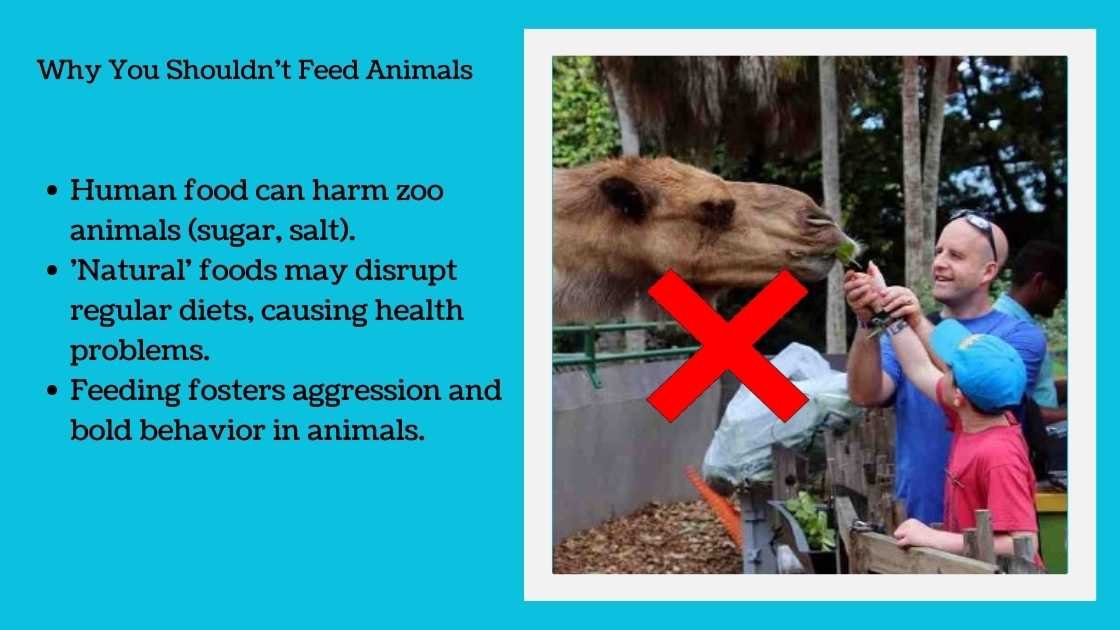Do not feed the animals or climb into enclosures at the zoo. Respect barriers and follow zoo guidelines.
Going to the zoo is super fun for families and people who love animals. You get to see cool animals from all over the world and learn interesting things about them.
But, hey, when you’re there, make sure you don’t do anything that could be unsafe for you or the animals. We want everyone to have a good time and stay safe!
When you visit the zoo, it’s important to know “What Not to Do at the Zoo?” Be kind to the animals and don’t do anything that might upset or harm them.
Follow the zoo rules and use your common sense to make sure the animals stay happy. This way, you help take care of them and support saving animals.
It makes the visit fun for everyone. Learn about the animals and how they live in the zoo. Be respectful to them and enjoy your time there!
Table of Contents
ToggleWildlife Etiquette

Welcome to the fun zoo! It’s a place with lots of cool animals and things to learn. To have a good time and be kind to the animals, let’s talk about the good stuff and what we shouldn’t do at the zoo.
Respect Animal Boundaries
Animals at the zoo need their own space, just like we do. It’s important to stay on the safe side of fences, glass, or ropes. These things keep both animals and visitors safe. Remember, don’t touch, feed, or tease the animals, as it can make them upset or hurt them.
- Observe animals from a distance.
- Never cross over barriers.
- Follow all zoo signage instructions.
Avoid Loud Noises
Animals are sensitive to sound. Loud noises can be frightening and trigger stress behavior. Always speak in soft tones. Never shout, bang on glass, or play loud music.
Creating a peaceful environment allows animals to behave naturally.
- Keep voices down near animal enclosures.
- Refrain from using sound-producing toys.
- Be mindful of the noise levels from electronic devices.
Feeding Faux Pas
Going to the zoo is super fun! You can learn cool things and see amazing animals. But, some people forget the rules about giving food to the animals.
It’s important to know the ‘Feeding Faux Pas’ so we don’t hurt our fuzzy and feathery pals. Let’s find out why the snacks we bring might not be good for them.
Why You Shouldn’t Feed Animals

Zoo animals are on special diets designed just for them. They eat foods that keep them healthy, much like you do at home. Feeding them from your hand can upset their nutrition and even make them sick. Here’s why you should resist the temptation:
- Human food often contains sugar, salt, and other things that can hurt zoo animals.
- Even ‘natural’ foods you bring could cause health problems if they’re not part of the animal’s regular diet.
- Feeding can encourage aggressive behavior, with animals fighting over treats or becoming too bold with humans.
Consequences Of Improper Diet
An improper diet can lead to serious issues for zoo animals. Poor nutrition can not only affect their physical health but also their mental well-being.
| Physical Health | Mental Well-being |
|---|---|
| Weight gain or loss | Stress and anxiety |
| Digestive problems | Abnormal behaviors |
| Nutrient deficiencies | Less interest in natural activities |
Such health issues can be life-threatening and shorten an animal’s lifespan. Always remember, feeding animals is a trained zookeeper’s job.
They know exactly what and how much to feed to keep the zoo’s residents thriving.
Photography Without Fright

Visiting the zoo is always an exciting experience. Capturing moments with your camera should not disturb the animals.
Keep in mind some simple rules for photography without fright to make sure you leave the zoo with great photos and a clear conscience.
Flash Photography Hazards
Animals are sensitive to sudden flashes of light. Using flash can scare them, causing stress or harm. Some effects of flash on zoo animals include:
- Disruption of their natural behavior
- Potential harm to their eyesight
- Stressful environment for nocturnal creatures
It’s best to turn off your camera’s flash. You can adjust other settings like ISO or exposure to compensate for low light.
Keeping A Safe Distance
Respecting an animal’s space is crucial. They react to close human presence. Here’s how to stay safe and respectful:
- Follow zoo barriers and signs.
- Use your zoom function instead of getting close.
- Keep quiet to avoid startling the animals.
Remember, your safety and the animals’ well-being are more important than a photo.
Safe Interactions
Visiting the zoo is an exciting adventure. But remember, zoos are not playgrounds. Safety comes first. Animals and humans must stay protected. This means following rules is a must. Let’s investigate some key dos and don’ts for safe zoo visits.
Barriers Are There For A Reason
Don’t go over, through, or touch the fences at the zoo. Fences keep everyone safe by keeping animals away from people. This helps prevent accidents and stops diseases from spreading.
Even though fences seem simple, they’re made carefully. Just stay where you’re supposed to and follow the paths with marks. Watch the animals from far away and enjoy!
Preventing Aggressive Encounters
Animals may feel threatened by certain actions. To prevent scary encounters:
- Avoid loud noises. Screaming or yelling can scare animals.
- Never throw objects. This could injure animals or provoke them.
- No teasing. Teasing can upset animals and cause aggression.
- Maintain a calm demeanor. Quick movements can alarm both animals and zoo staff.
Follow these tips and enjoy an amazing, safe zoo experience.
Trash Troubles
Visiting the zoo can be a joyful and educational experience. But, our behavior has a big impact. Trash troubles are a serious issue at zoos. They affect animals, staff, and the environment. Let’s be responsible and keep the zoo clean.
Hazards Of Littering
Why should we avoid littering? Dropping the trash can lead to big problems:
- Animals might eat harmful garbage by mistake.
- Litter can trap or injure curious creatures.
- Clean-up costs rise, which can affect ticket prices.
Chemicals from trash also pollute water and soil. This can make animals sick. Our fun day out shouldn’t hurt our animal friends.
Proper Waste Disposal
Keeping the zoo clean is easy:
- Always use the bins provided.
- Recycle when possible.
- Have trash but can’t find a bin? Hold onto it until you do.
Some zoos have composting options for food waste. Use these to help the environment. A clean habitat is a happy habitat.
Pathway Problems
Zoos have cool animals and fun stuff to see, but it’s super important to follow the rules for a safe visit. One big rule is about walking on the right paths.
Staying on the right path keeps everyone safe, even the animals. Let’s talk about what you shouldn’t do on the paths at the zoo.
Sticking To Designated Paths
Designated paths guide visitors safely through the zoo. These are the only routes visitors should take. By staying on the paths, guests avoid trampling plants, bothering animals, and getting lost.
- Avoid creating shortcuts through exhibits or over fences.
- Never climb or lean on barriers or fences.
- Use walkways to respect the zoo’s design and habitat.
Avoiding Restricted Areas
Restricted areas are off-limits for a reason. These might house sensitive equipment, special animal diets, or be part of staff-only zones.
- Obey all signs that display “Do Not Enter” or “Staff Only”.
- Stay out of closed-off areas, even if they look inviting.
- Ask staff for directions if unsure about an area’s accessibility.
Supervising Children
Watching over kids at the zoo is important. It helps everyone have a good and safe time. Zoos are not just for fun and learning.
They’re places where little ones need careful eyes to keep them safe and make sure they don’t bother the animals.
Now, let’s talk about important tips to keep things safe and organized during your family zoo trip.
Keeping Kids Close

Zoos can be crowded and confusing places for children. Losing sight of your child is a scary possibility. Here’s what you can do to prevent it:
- Hold hands in crowded spots.
- Use colorful clothing or accessories to spot them easily.
- Designate a meeting place in case you get separated.
Enforce the buddy system for siblings or friends, ensuring they look out for each other.
Teaching Zoo Safety
Teaching kids zoo etiquette is as important as keeping them close. Here’s how:
- Stay on marked paths and respect barriers.
- Don’t tease or feed the animals.
- No yelling or running as it can scare animals and people.
Ensure they understand the signs and follow zoo rules. Empower them with knowledge, and you’ll have a visit that’s not only enjoyable but educational too.
Viewing With Patience
Welcome to an essential guide on what not to do at the zoo! Zoos offer a unique chance to admire the beauty and diversity of animals from around the world. Yet, a respectful and patient approach improves not just your visit but everyone else’s.
Viewing with patience stands out as a key practice. It ensures all guests enjoy their time.
Waiting Your Turn
Animals may not always be active or visible, and popular exhibits get crowded. Rushing or pushing to get a better view spoils the fun. Follow these steps:
- Stand in line where applicable.
- Wait for others to move on.
- Take your time observing, but also move on in time.
Zoo visits are not races. Enjoy them at a leisurely pace.
Respecting Others’ Experience
Every visitor wishes for a pleasant zoo experience. To ensure this:
- Keep voices down near animal enclosures.
- Avoid blocking views with big hats or raised cameras.
- Take pictures swiftly to allow others a chance.
Your patience and courtesy make the visit enjoyable for all.
Frequently Asked Questions On What Not To Do At The Zoo
What To Do And Not To Do In The Zoo?
At the zoo, do follow posted signs, stay on designated paths, and respect barriers. Do not feed the animals, tease them, or litter. Always supervise children and maintain a quiet demeanor to enjoy a safe, educational visit while preserving animal welfare.
What Should You Be Careful Of When You Go To The Zoo?
Observe zoo rules and signage closely. Avoid feeding or teasing animals. Stay on designated paths for safety. Supervise children at all times. Do not litter or damage zoo property.
Why Not To Go To The Zoo?
Some people avoid zoos due to concerns about animal welfare and ethics. They prefer observing animals in their natural habitats or supporting wildlife sanctuaries that provide more space and natural living conditions.
What Precaution Should The Visitors Take While Moving Around The Zoo?
Always follow the zoo’s posted signs and guidelines. Stay on designated pathways at all times. Avoid feeding or touching the animals. Supervise children closely to ensure their safety. Respect barriers and keep noise to a minimum to avoid disturbing wildlife.
Conclusion
Wrapping up our zoo visit tips, remember respect is key. Animals and staff alike deserve considerate observers. Avoid the don’ts highlighted here, and you’ll enjoy a rewarding, educational experience. Share responsibly, embrace the learning opportunity, and cherish your zoo adventure responsibly.
Let’s make every zoo trip memorable—for the right reasons.



